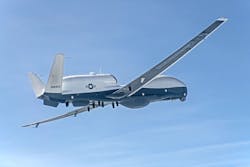Multi-intelligence sensors version of MQ-4C long-range reconnaissance unmanned aircraft flies for first time
SAN DIEGO – A Northrop Grumman MQ-4C Triton drone equipped with an upgraded multi-intelligence sensors package called Integrated Functional Capability Four (IFC-4), has taken to the air for the first time. New Atlas reports. Continue reading original article
The Military & Aerospace Electronics take:
19 Aug. 2021 -- The turbofan-powered robotic aircraft in its new configuration is being developed by the Northrop Grumman Corp. Aeronautics Systems sector in San Diego for the U.S. Navy and the Royal Australian Air Force (RAAF) for advanced long-endurance maritime intelligence, surveillance, and reconnaissance.
Since its first test flight in 2013, the subsonic Triton unmanned aerial vehicle (UAV) has grown in capabilities that have transformed it from a maritime-patrol remotely operated unmanned aircraft to a semi-autonomous UAV that could revolutionize how the Navy and the RAAF carry out maritime patrol and reconnaissance.
In its latest configuration, the MQ-4C Triton combines its High-Altitude, Long-Endurance (HALE) capabilities with multi-intelligence systems that bring to bear state-of-the-art radar and other sensors as well as very high-bandwidth multiple data feeds. This provides for much greater situational awareness.
Related: Sensor payloads for unmanned vehicles
John Keller, chief editor
Military & Aerospace Electronics
